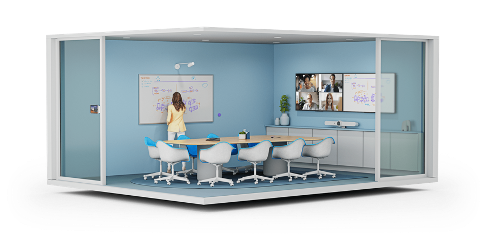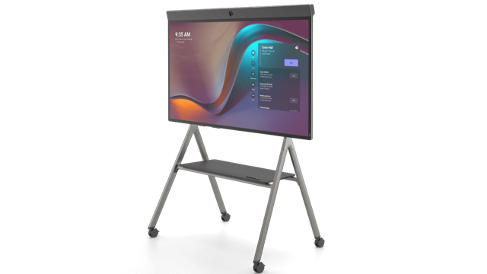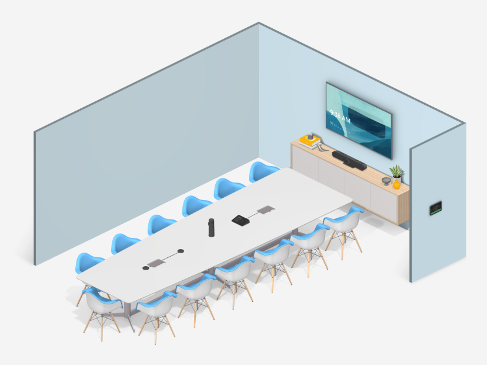Revolutionising Work Culture: Unveiling the Future of Meeting Room Conferencing Systems
Rich Marshall • August 31, 2023
In the wake of the pandemic, the world witnessed a seismic shift in the way we work, communicate, and collaborate. With the rise of remote and hybrid work models, traditional meeting room dynamics were upended. As organisations navigated this new landscape, the spotlight turned towards meeting room conferencing systems - the backbone of seamless virtual interactions. Let’s delve into the innovative evolution of these systems, while also shedding light on a critical yet often overlooked aspect: room acoustics.

Embracing a New Era of Connectivity
Innovation has always been the driving force behind progress, and the realm of meeting room conferencing systems is no exception. As businesses adapt to the "new normal," a myriad of innovative solutions have emerged to redefine the virtual meeting experience. Today's conferencing systems are more than just video and audio; they encompass a holistic approach to collaboration. Imagine a scenario where team members from Auckland, Wellington, and Christchurch collaborate effortlessly as if they were in the same room. This seamless integration of technology transcends geographical boundaries, fostering a stronger sense of unity among remote and in-house teams alike.

Simplicity in Complexity
In the world of technology, simplicity is the ultimate sophistication. The evolution of meeting room conferencing systems revolves around simplicity as a guiding principle. These systems have undergone a transformation from complex and cumbersome setups to user-friendly interfaces that require little more than a touch to initiate a conference call. With intuitive controls and streamlined processes, even the least tech-savvy individual can effortlessly connect, share insights, and drive projects forward. This user-centric approach paves the way for a future where technology empowers, not intimidates.

Inspiring Productivity and Engagement
Innovation goes hand in hand with inspiring productivity. Today's meeting room conferencing systems are designed to do more than just replicate face-to-face interactions; they aim to enhance them. Features like real-time document collaboration, virtual whiteboards, and breakout rooms encourage engagement and creative brainstorming, fostering an environment where ideas flow freely across the digital realm. This newfound synergy enables teams to harness the power of collective intelligence, resulting in solutions that are as diverse as they are ground-breaking.
The Silent Hero: The Importance of Room Acoustics
In the quest for seamless virtual communication, there's one unsung hero that often escapes our attention: room acoustics. Imagine being in a meeting where every word spoken echoes or is drowned out by an incessant hum. Room acoustics play a pivotal role in the clarity of audio during virtual meetings. They can be the difference between a productive conversation and a frustrating ordeal.

Ensuring Good Acoustics: A Sonic Symphony
Good acoustics aren't just about ensuring that every voice is heard; they're about creating an environment where every sound is crisp, clear, and devoid of distractions. Achieving this sonic symphony requires attention to detail. Start by assessing the room's design. Are there hard, reflective surfaces that bounce sound waves chaotically? Consider incorporating softer materials, such as curtains or acoustic panels, to absorb excess sound and prevent echoes.
Furthermore, the placement of microphones and speakers is of paramount importance. Innovative conferencing systems often come equipped with intelligent microphone arrays that adapt to the speaker's location. Position speakers strategically to ensure an even distribution of sound. Remember, the goal is to create an immersive audio experience that transcends physical boundaries.

When Acoustics Fall Short: Finding Harmony
Even with the best intentions, sometimes acoustics fall short of the mark. The tell-tale signs are hard to miss: echoes, a muffled sound, or persistent background noise. When faced with subpar acoustics, it's crucial not to throw in the towel. There are solutions that can turn the tide and restore the harmonious balance of sound.
One straightforward approach is investing in acoustic treatment. This can involve adding sound-absorbing materials like foam panels, diffusers, and bass traps strategically around the room. These additions can make a world of difference by taming sound reflections and minimising unwanted noise.
In cases where the room itself isn't the issue, it's essential to consider the quality of conferencing equipment. Innovations in audio technology have led to the development of advanced noise cancellation algorithms, beamforming microphones, and echo suppression mechanisms. Upgrading to such cutting-edge solutions can mitigate acoustic challenges and ensure that every meeting is an auditory delight.
In Conclusion: A Harmonious Future Beckons
As we embrace the evolution of post-pandemic work culture, the trajectory of meeting room conferencing systems is nothing short of inspiring. From fostering connectivity across continents to simplifying complex interactions, these systems are catalysts for collaboration in an increasingly digital world. Amidst this innovative wave, let us not forget the significance of acoustics. They are the invisible threads that weave the tapestry of a productive meeting, and their influence should never be underestimated. By embracing thoughtful room design, strategic placement of equipment, and cutting-edge technology, we can ensure that our virtual interactions resonate with clarity, fostering a harmonious future of work.
Recent Posts




